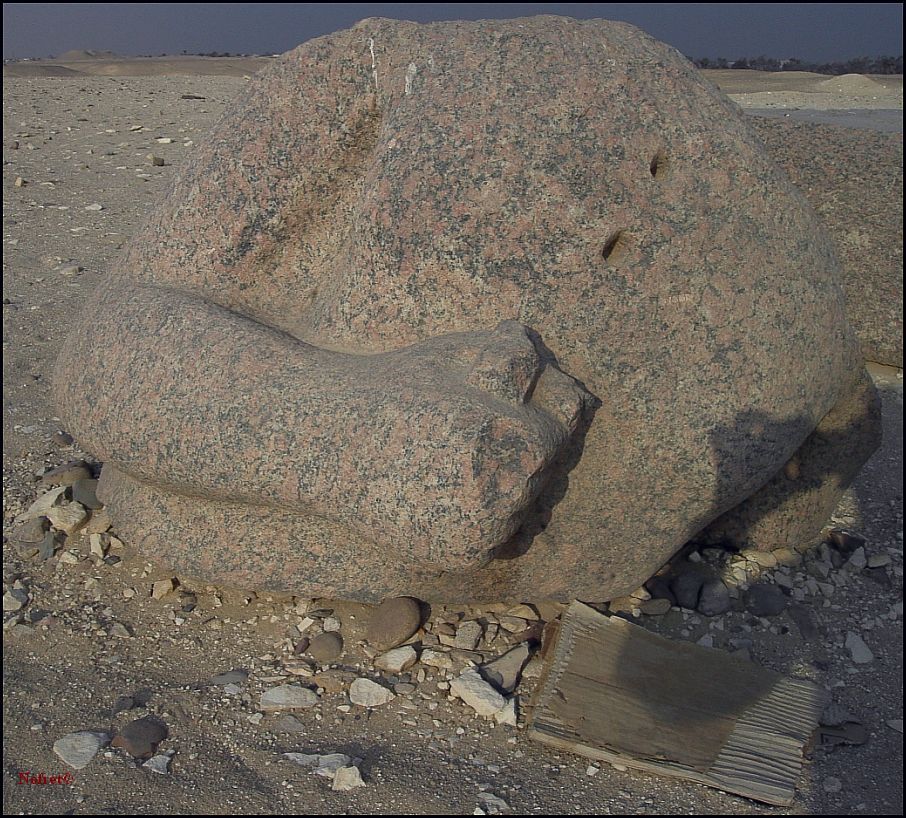The second extension turned the original step pyramid design into a true pyramid by filling in the steps with limestone encasing. While this approach is consistent with the design of the other true pyramids, a couple of fatal errors were made at Meidum. Firstly, the outer layer was founded on sand and not on rock, like the inner layers. Secondly, the inner step pyramids had been designed as the final stage. Thus the outer surface was polished and the platforms of the steps were not horizontal, but fell off to the outside. This severely compromised the stability and is likely to have caused the collapse of the Meidum Pyramid in a downpour while the building was still under construction.
By the time it was investigated by Napoleon's Expedition in 1799 the Meidum Pyramid had its present 3 steps. It is commonly assumed the pyramid still had 5 steps in the fifteenth century and was gradually falling further into ruin, because al-Maqrizi described it as looking like a five-stepped mountain. But Mendelssohn claimed this might be the result of a loose translation and al-Makrizi's words would more accurately translate into "five-storied mountain". A description which could even match the present state of the pyramid with four bands of different masonry at the base and a step on top.
Bron: http://en.wikipedia.org/wiki/Meidum
De trappenpiramide van Snofroe van Meidoem is een Egyptische piramide, had een oorspronkelijke hoogte van 93,5 meter en de lengte van de zijde bedraagt 147 m.
De piramide wordt toegeschreven aan Snofroe. Omwille van enkele graffiti uit het Nieuwe Rijk die in de grafkamer zijn aangebracht, bestaat er twijfel of ze wel van hem is en niet van zijn vader Hoeni. De piramide is immers nog een trappiramide en geen 'echte' piramide. Toch staat er ook nergens een vermelding van Hoeni, dus voorlopig is het nog onduidelijk. De afwerking van de piramide is zeker door Snofroe gebeurd, want er zijn verschillende graffiti van de arbeiders op de blokken. De twijfel dat Snofroe hem bouwde ligt aan het feit dat deze nog twee andere piramiden heeft gebouwd: de (Rode piramide van Snofroe en de knikpiramide van Snofroe.
De noordzijde van de piramide bevat de toegang tot een ondergrondse kamer, waar een ondergrondse grafkamer (zonder sarcofaag) in is. Auguste Mariette was in 1881 de eerste die de piramide binnendrong.
De piramide heeft een zeer bizarre vorm: ze heeft een grote basis, maar versmalt dan plots. Er zijn verschillende theorieën hiervoor:
- symbool voor de zonnestralen (vergelijk: obelisk)
- een deel van de deklaag is weg
- de piramide is onafgewerkt







































_filtered.jpg)
.jpg)
.jpg)
.jpg)
.jpg)
.jpg)
.jpg)
.jpg)
.jpg)
.jpg)
.jpg)
.jpg)
.jpg)
.jpg)
.jpg)
.jpg)
.jpg)
.jpg)
.jpg)
.jpg)
.jpg)
.jpg)
.jpg)
.jpg)
.jpg)
.jpg)
.jpg)
.jpg)
.jpg)
.jpg)
.jpg)
.jpg)
.jpg)
.jpg)
.jpg)
.jpg)
.jpg)
.jpg)
.jpg)
.jpg)
.jpg)
.jpg)
.jpg)
.jpg)
.jpg)
.jpg)
.jpg)
.jpg)
.jpg)
.jpg)
.jpg)
.jpg)
.jpg)
.jpg)
.jpg)
.jpg)
.jpg)
.jpg)
.jpg)
.jpg)
.jpg)
.jpg)
.jpg)
.jpg)
.jpg)
.jpg)
.jpg)
.jpg)
.jpg)
.jpg)
.jpg)
.jpg)
.jpg)
.jpg)
.jpg)
.jpg)
.jpg)
.jpg)
.jpg)






.jpg)

